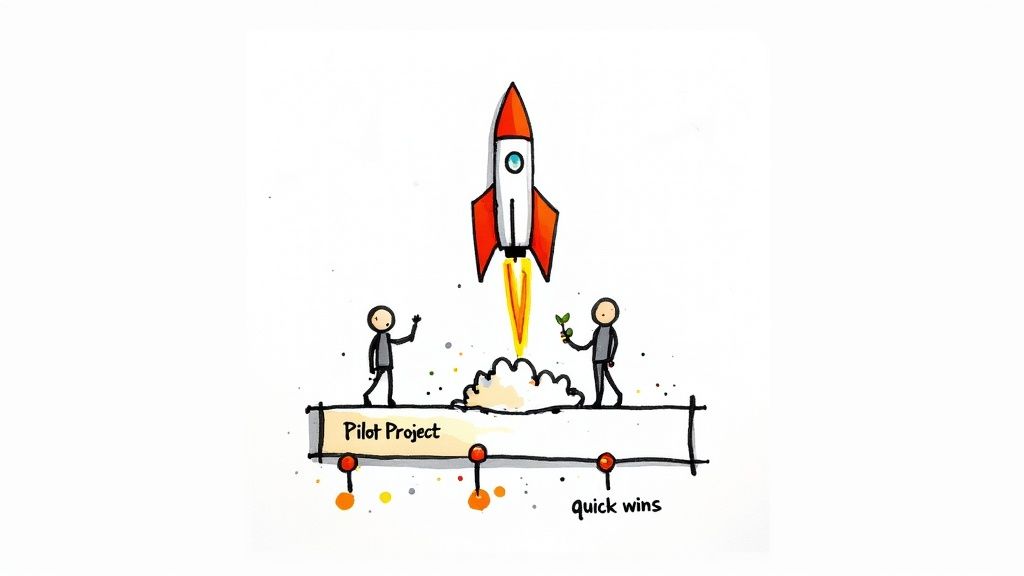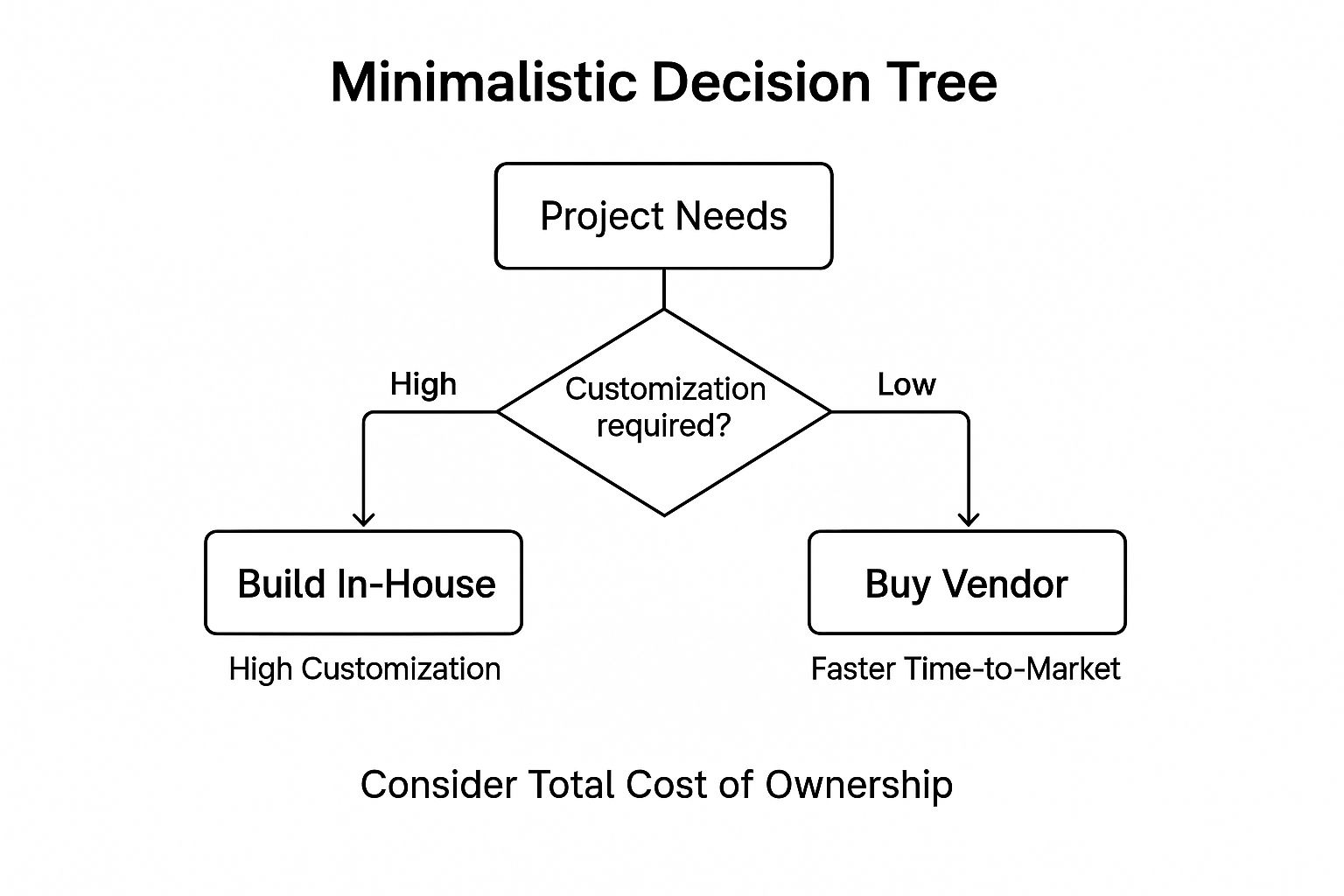9 Key AI Adoption Strategies for Success
Discover 9 proven AI adoption strategies to drive business growth. Our guide covers pilots, data, talent, and ethics for a successful transformation.

Artificial intelligence is no longer a futuristic concept; it's a present-day business reality. Yet, transitioning from understanding AI's potential to successfully integrating it into your operations presents a significant challenge. Many organisations falter, not due to a lack of ambition, but a lack of a clear, actionable plan. A scattergun approach leads to wasted resources, stalled projects, and a failure to realise true value. Effective AI adoption strategies are crucial for navigating this complexity and ensuring technology investments translate into measurable business outcomes.
This article provides a blueprint for success, moving beyond abstract theories to offer a curated list of proven strategies. We will dissect nine distinct approaches, from initiating targeted pilot projects to establishing a robust, ethics-first governance framework. You will gain practical insights into developing a data-first mindset, deciding whether to buy or build solutions, and fostering the right internal talent. Each strategy is designed to be a building block for a comprehensive and customised plan, whether you are just starting or looking to refine your current methods. For leaders seeking a structured approach, an effective AI strategy framework can provide the necessary foundation for these initiatives, guiding you from initial concept to successful implementation.
1. Start Small with Pilot Projects
Embarking on your AI journey doesn't require a massive, organisation-wide overhaul from day one. One of the most effective AI adoption strategies involves starting with small-scale, low-risk pilot projects. This approach, popularised by consulting leaders like McKinsey & Company, focuses on identifying specific, high-impact business problems that can be addressed with AI, thereby minimising initial investment and mitigating potential risks.

The core idea is to secure quick, demonstrable wins. These successful pilots generate crucial momentum, build organisational confidence, and provide invaluable lessons for future, larger-scale implementations. For instance, JPMorgan Chase's famous COIN program began as a pilot to analyse commercial loan agreements, a task that once consumed 360,000 legal hours annually. Its success paved the way for broader AI integration. Similarly, Starbucks first trialled predictive analytics for inventory management in a handful of stores before rolling it out globally.
How to Implement This Strategy
To successfully launch an AI pilot, focus on clarity and measurement. This iterative method, as we explored in our AI adoption guide, allows your organisation to learn and adjust without committing vast resources.
Choose Wisely: Select a pilot with clear business value and easily measurable outcomes, such as cost reduction or efficiency gains.
Data Readiness: Ensure the project has access to sufficient, high-quality data. Poor data is a common reason for AI project failure.
Involve End-Users: Engage the team members who will ultimately use the AI solution from the very beginning to ensure it meets their needs and to foster early adoption.
Document Everything: Keep detailed records of the process, challenges, and successes. This documentation becomes a vital playbook for scaling up.
Set Realistic Goals: Define achievable timelines and expectations to avoid disillusionment. A successful pilot proves value, it doesn't need to transform the entire company overnight.
2. Adopt a Data-First Strategy
Many organisations rush into AI, only to find their efforts stalled by inadequate data. A superior approach among AI adoption strategies is to prioritise building a strong data foundation before deploying complex solutions. This data-first method, championed by leaders in the Chief Data Officer movement and platforms like Snowflake, recognises a fundamental truth: AI algorithms are only as effective as the data they are trained on. It involves establishing robust data governance, quality, and infrastructure as prerequisites for success.

This strategy treats data as a core strategic asset. For example, Mastercard invested heavily in its real-time data processing infrastructure, which became the bedrock for its world-class fraud detection systems. Similarly, Walmart's creation of a massive data lake was a foundational move that now supports numerous AI applications, from supply chain optimisation to personalised customer promotions. These companies understood that cleaning, organising, and governing their data first would unlock greater, more reliable AI capabilities later.
How to Implement This Strategy
Implementing a data-first strategy requires a systematic and organisation-wide commitment to data excellence. This forms a critical part of any comprehensive AI strategy framework, ensuring that future investments yield maximum returns.
Conduct a Data Inventory: Begin by cataloguing all existing data sources to understand what you have, where it is, and its current state. You can accelerate this with an AI requirements analysis tool.
Establish Governance: Define clear data ownership and stewardship roles. This ensures accountability for data quality and security.
Invest in Tools: Utilise modern data integration, cleansing, and management tools to automate and streamline data preparation.
Measure Quality: Create and monitor specific data quality metrics (e.g., completeness, accuracy, timeliness) to maintain high standards.
Build Data Literacy: Organise training to enhance the data skills of employees across all departments, fostering a data-driven culture.
3. Centre of Excellence (CoE) Model
To scale AI initiatives effectively beyond initial pilots, many organisations establish a dedicated AI Centre of Excellence (CoE). This centralised hub serves as the core of your company's AI knowledge, talent, and governance. Promoted by thought leaders like Deloitte and PwC, this approach standardises best practices, ensuring that AI adoption strategies are applied consistently and efficiently across all departments.
The primary function of a CoE is to centralise expertise and resources, preventing siloed efforts and redundant work. It acts as an internal consultancy, guiding business units through their AI journey, from ideation to implementation. For example, Microsoft's internal AI CoE not only drives its own product innovation but also provides the framework for initiatives like AI for Good. Similarly, General Electric's digital transformation was accelerated by a central hub focused on analytics and AI, enabling widespread capability building.
How to Implement This Strategy
A successful CoE balances governance with enablement, empowering business units rather than simply controlling them. This requires a strategic blend of technical skill and business acumen, which can be developed through a robust AI strategy framework.
Staff for Synergy: Build a cross-functional team with both technical experts (data scientists, ML engineers) and business strategists who understand the company's operational needs.
Prioritise Enablement: Focus on creating reusable tools, providing training, and offering expert consultation. The goal is to make it easier for business units to succeed with AI.
Maintain Business Links: Keep the CoE closely connected to the business units it serves. Regular communication and joint projects ensure its work remains relevant and impactful.
Establish Clear Governance: Develop standards for data usage, model development, ethics, and security. This creates a safe and consistent environment for innovation.
Communicate Value: Regularly track and report on the CoE's impact, using metrics like project success rates, cost savings, or revenue generated to demonstrate its worth to the organisation.
4. Buy vs. Build Decision Framework
One of the most critical junctures in any AI initiative is deciding whether to purchase an off-the-shelf solution or build a custom one in-house. A formal AI adoption strategy must include a Buy vs. Build Decision Framework. This structured approach, championed by industry analysts like Gartner and Forrester, moves beyond simple cost comparisons to systematically evaluate factors like time-to-market, competitive differentiation, and internal capabilities.
The framework guides organisations in making a strategic choice that aligns with long-term business goals. For example, a company might choose to "buy" a pre-built chatbot platform like Google's Dialogflow for standard customer service queries to achieve rapid deployment. Conversely, a financial institution might "build" a proprietary fraud detection algorithm to create a unique competitive advantage not available from commercial vendors. The key is to weigh the trade-offs between speed, control, and strategic value.
This decision tree infographic illustrates the fundamental choices in the Buy vs. Build evaluation.

As the flow demonstrates, projects requiring high customisation often lead to an in-house build, while those prioritising speed and standard features favour buying a vendor solution, always considering the total cost.
How to Implement This Strategy
A robust framework prevents organisations from defaulting to one path without proper consideration. Developing an AI strategy framework ensures these decisions are made consistently and effectively across the business.
Develop Clear Criteria: Define and weight evaluation criteria based on business priorities. Key factors include strategic importance, required customisation, data privacy, and speed to market.
Assess Total Cost of Ownership (TCO): Look beyond the initial purchase or development price. Factor in ongoing costs for maintenance, support, data infrastructure, and necessary talent over a 3-5 year period.
Evaluate Vendor Viability: If considering a "buy" option, scrutinise the vendor’s stability, customer support reputation, and product roadmap to ensure long-term alignment with your needs.
Gauge Internal Capabilities: Honestly assess your team's skills, capacity, and expertise. Do you have the necessary data scientists, engineers, and MLOps professionals to build and maintain a custom solution?
Consider Hybrid Approaches: The best solution is often a hybrid. You might buy a core AI platform and then build custom models or integrations on top of it to get the best of both worlds.
5. Foster a Talent-Centric Approach
Technology alone cannot drive transformation; people do. A powerful AI adoption strategy centres on cultivating human talent, recognising that the right skills are the true engine of innovation. This approach, championed by leaders like Andrew Ng and organisations like Fast.ai, prioritises building in-house AI capabilities through strategic hiring, upskilling, and retention, ensuring your workforce is ready to leverage AI effectively.

This strategy acknowledges that AI success is less about buying tools and more about empowering people. For example, Amazon established its internal Machine Learning University to upskill its existing employees, while Google’s AI Residency Program acts as a pipeline for nurturing top-tier talent. Similarly, Airbnb has been deliberate in its hiring strategy, building world-class data science and machine learning engineering teams to drive its product innovation from the ground up.
How to Implement This Strategy
To build a robust, AI-ready team, focus on creating an environment where talent can thrive. This involves a mix of external recruitment and internal development, supported by a strong organisational culture that values continuous learning. Building this capability is a core part of how our expert team delivers sustainable results.
Create Clear Career Paths: Define attractive career trajectories for AI and data professionals to improve retention and attract top talent.
Invest in Continuous Learning: Offer ongoing training, workshops, and access to resources to keep your team’s skills current with the rapidly evolving AI landscape.
Partner with Academia: Collaborate with universities and colleges to create a talent pipeline by offering internships, sponsoring research, and participating in career fairs.
Build Diverse Teams: Assemble cross-functional teams with a mix of technical, business, and domain expertise to foster holistic problem-solving.
Encourage Knowledge Sharing: Establish mentorship programmes and internal communities of practice to allow skills and best practices to spread organically throughout the organisation.
6. Industry-Specific AI Implementation
Generic, one-size-fits-all AI tools often fail to address the nuanced challenges and regulatory landscapes of specific sectors. A powerful AI adoption strategy is to prioritise solutions explicitly designed for your industry. This approach, championed by companies like Palantir and Salesforce with their vertical-specific platforms, leverages pre-built domain expertise to accelerate value realisation and ensure relevance.
An off-the-shelf solution may not understand the intricacies of financial compliance or the specific predictive needs of pharmaceutical manufacturing. Industry-specific AI is engineered with this context in mind, providing a significant head start. For instance, in healthcare, systems like IBM Watson for Oncology are trained on specialised medical data to assist clinicians. Similarly, financial services firms utilise AI trained specifically for fraud detection patterns unique to their transaction types, while retailers deploy engines fine-tuned for demand forecasting in their product categories.
How to Implement This Strategy
Adopting industry-specific AI means you're not just buying technology; you're investing in a solution that speaks your business language. This targeted approach, a key component of a robust AI strategy framework, helps bypass extensive customisation and ensures alignment with sector-specific regulations and operational workflows from day one.
Partner with Specialists: Seek out vendors who specialise in your industry. Their solutions are more likely to have the features and compliance measures you need.
Engage Industry Groups: Participate in industry consortiums and associations focused on technology. These groups are valuable for discovering proven solutions and best practices.
Focus on High-Impact Use Cases: Identify problems unique to your sector that offer the highest return, such as predictive maintenance in manufacturing or personalised customer journeys in retail.
Prioritise Compliance: Ensure any potential AI solution meets strict industry regulations (e.g., GDPR in Europe, HIPAA in healthcare) from the outset.
Learn from Peers: Study successful AI implementations by similar organisations in your industry to understand what works and avoid common pitfalls.
7. Adopt an Agile AI Development Methodology
Traditional software development lifecycles often prove too rigid for the experimental nature of AI. Adopting an Agile AI Development Methodology adapts agile principles for AI projects, emphasising iterative development, continuous testing, and rapid adaptation. This is one of the most dynamic AI adoption strategies because it directly addresses the unique challenges of AI, such as data dependencies and model performance variability.
This approach, championed by platforms like DataRobot and H2O.ai, breaks down a large AI initiative into smaller, manageable cycles or "sprints." Each sprint aims to deliver a tangible improvement, whether it's enhancing data quality, refining a model, or deploying a new feature. For instance, Spotify continuously evolves its music recommendation system through small, agile experiments. Similarly, Uber refines its demand forecasting and dynamic pricing algorithms through constant, iterative updates rather than large, infrequent overhauls. This ensures the final solution is robust, relevant, and delivers consistent business value.
How to Implement This Strategy
To successfully apply agile principles to AI, your focus must shift from a fixed plan to continuous learning and value delivery. This method embraces the inherent uncertainty in AI development, allowing your organisation to pivot quickly based on new insights.
Establish Clear Sprint Metrics: Define specific, measurable success criteria for each iteration, such as an increase in model accuracy or a reduction in prediction latency.
Implement Robust Versioning: Use tools like MLflow to track experiments, manage data versions, and version control your models. This is crucial for reproducibility and auditing.
Create Tight Feedback Loops: Regularly involve end-users and business stakeholders to test and validate model outputs, ensuring the AI solution truly solves their problem.
Automate Testing and Validation: Build automated pipelines to continuously test data quality, model performance, and system integration, accelerating the development cycle.
Maintain Focus on Business Value: Each sprint's goal should be directly linked to a business outcome. This prevents teams from getting lost in purely technical research and aligns the project with your overarching AI strategy framework.
8. Partnership and Ecosystem Strategy
Building a robust AI capability entirely in-house is a monumental task. A powerful alternative involves leveraging external partnerships and ecosystems to accelerate your AI adoption. This approach focuses on collaborating with technology providers, research institutions, and AI specialists to access capabilities, knowledge, and resources that would be difficult or too costly to develop internally, making it one of the most pragmatic AI adoption strategies.
This model is heavily championed by major cloud providers like Amazon Web Services through its AI/ML partner network and Google Cloud's AI partner program. For instance, NVIDIA's partnerships with automotive companies like Mercedes-Benz accelerate the development of autonomous driving technology by combining NVIDIA's AI platform with the automaker's engineering expertise. Similarly, IBM’s Watson ecosystem has enabled businesses across healthcare and finance to deploy sophisticated AI without building foundational models from scratch.
How to Implement This Strategy
A successful partnership strategy hinges on clear alignment and strong governance. This collaborative approach, often part of a broader AI strategy framework, allows you to tap into specialised expertise and cutting-edge technology, fast-tracking your own journey.
Define Clear Objectives: Explicitly state what you want to achieve from the partnership, whether it's access to technology, market entry, or research and development collaboration.
Establish Strong Governance: Create clear communication channels, decision-making processes, and roles to manage the relationship effectively and avoid misunderstandings.
Protect Intellectual Property: Implement robust agreements that protect your company's IP while still enabling the collaboration needed for mutual success.
Choose Complementary Partners: Select partners whose strengths complement your weaknesses and whose organisational culture and goals are aligned with your own.
Diversify Your Ecosystem: Avoid over-reliance on a single partner. Building a small, diverse network of collaborators provides flexibility and reduces risk.
9. Ethics-First AI Governance
Integrating AI responsibly means placing ethical considerations at the forefront of your strategy. This AI adoption strategy involves establishing robust governance frameworks and ethical guidelines from the very beginning to ensure fairness, transparency, and accountability. This proactive approach, championed by figures like Timnit Gebru and Cathy O'Neil, ensures AI systems are deployed responsibly, mitigating legal, reputational, and societal risks.
An ethics-first mindset moves beyond mere compliance to build genuine trust with customers, employees, and regulators. Tech giants like Microsoft with its Responsible AI practices and Google with its published AI Principles have demonstrated the importance of this. They actively develop toolkits to detect bias and create oversight boards to guide development. Salesforce’s Ethical Use of Technology framework is another prime example of embedding ethical decision-making directly into the innovation lifecycle, rather than treating it as an afterthought.
How to Implement This Strategy
Implementing an ethics-first framework requires a deliberate, organisation-wide commitment. Building this into your AI strategy framework ensures that principles translate into practice and are not just words on a page.
Establish Clear Guidelines: Define and document your organisation's ethical principles for AI, covering areas like fairness, privacy, security, and transparency.
Create Diverse Teams: Assemble cross-functional teams with diverse backgrounds and perspectives to review AI projects and identify potential ethical blind spots.
Implement Bias Monitoring: Use specialised tools and processes to test for and mitigate algorithmic bias throughout the AI model's lifecycle, from data collection to deployment.
Prioritise Explainability: Build transparency and explainability (XAI) into your systems from the start, ensuring you can articulate how your AI models arrive at their decisions.
Engage External Experts: Collaborate with external stakeholders, ethicists, and academics to review your policies and provide independent oversight.
AI Adoption Strategies Comparison Matrix
Strategy | Implementation Complexity | Resource Requirements | Expected Outcomes | Ideal Use Cases | Key Advantages |
|---|---|---|---|---|---|
Start Small with Pilot Projects | Low to moderate | Limited initial investment | Quick wins, measurable pilot results | Testing AI value with low risk | Low financial risk, faster value demonstration, builds AI literacy |
Data-First Strategy | High | Significant investment in data | High-quality, reliable AI outcomes | Building foundational data systems | Ensures data quality, reduces bias, supports multiple AI use cases |
Center of Excellence (CoE) Model | Moderate to high | Investment in specialized talent | Standardized AI practices and governance | Centralized AI expertise management | Avoids duplication, consistent standards, accelerates adoption |
Buy vs. Build Decision Framework | Moderate | Variable based on choice | Optimized resource use, faster time-to-market | Deciding on AI solution sourcing | Optimizes investment, access to vendor expertise, faster scaling |
Talent-Centric Approach | Moderate to high | High costs for talent and training | Strong internal AI capabilities | Building AI workforce and expertise | Sustainable advantage, innovation, reduced external dependency |
Industry-Specific AI Implementation | Moderate to high | Specialized solutions and compliance | Effective, compliant industry AI | Industry-focused AI applications | High relevance, built-in compliance, stronger ROI |
Agile AI Development Methodology | Moderate | Cross-functional team efforts | Faster, flexible AI project delivery | Iterative AI development projects | Faster time-to-market, better alignment with business needs |
Partnership and Ecosystem Strategy | Moderate | Collaboration management | Accelerated AI adoption and innovation | Leveraging external capabilities | Access to expertise, shared risk, broader resources |
Ethics-First AI Governance | Moderate to high | Resources for oversight and auditing | Responsible, fair AI deployment | Ethical and compliant AI use | Builds trust, reduces risks, supports regulatory compliance |
Turning Strategy into Action with the Right Partner
Navigating the complexities of artificial intelligence is no longer a futuristic endeavour; it is a present-day strategic imperative. The journey from initial concept to full-scale implementation is paved with critical decisions, each one shaping your organisation's future competitiveness. Throughout this guide, we have explored a comprehensive suite of AI adoption strategies, moving beyond generic advice to provide a tangible roadmap for success. We have seen how starting with targeted pilot projects de-risks investment and builds momentum, while a robust data-first strategy creates the very foundation upon which intelligent systems are built.
The key takeaway is that a successful AI transformation is not about adopting a single, magic-bullet solution. It is about weaving together multiple strategic threads:
Establishing a Centre of Excellence (CoE) to centralise expertise and drive governance.
Utilising a clear Buy vs. Build framework to make smart resource allocation decisions.
Cultivating in-house talent and fostering an AI-literate culture.
Implementing an ethics-first governance model to build trust and ensure responsible innovation.
Mastering these approaches provides more than just a technological edge; it fundamentally reorients your organisation towards agility, data-driven decision-making, and continuous improvement. The real power of these AI adoption strategies is realised when they are integrated into a cohesive, overarching plan, much like the one detailed in our comprehensive AI strategy framework. This integrated approach transforms AI from an isolated tool into a core driver of business value, unlocking efficiencies and creating new opportunities for growth that were previously unimaginable.
Your Next Steps Towards AI Mastery
Embarking on this journey requires not just a plan but also a partner who understands the intricate balance between technology, people, and process. The strategies we have discussed, from agile development to forging strategic partnerships, underscore a critical theme: you do not have to navigate this complex landscape alone. Effective AI co-creation with seasoned experts can dramatically accelerate your timeline, mitigate risks, and ensure your initiatives are aligned with proven methodologies and real-world success stories. By leveraging the expertise of a dedicated partner using an AI Strategy consulting tool, you can confidently translate your strategic vision into impactful, real-world results. For more inspiration, exploring a curated database of real-world use cases can help spark ideas tailored to your specific industry challenges. Your path to AI maturity begins now, and with the right support, it can lead to transformative outcomes.
Ready to move from strategy to execution with confidence? The experts at Ekipa AI specialise in turning ambitious AI visions into reality through hands-on AI strategy consulting and co-creation. Partner with our expert team to build a bespoke AI roadmap that drives measurable results for your organisation.



